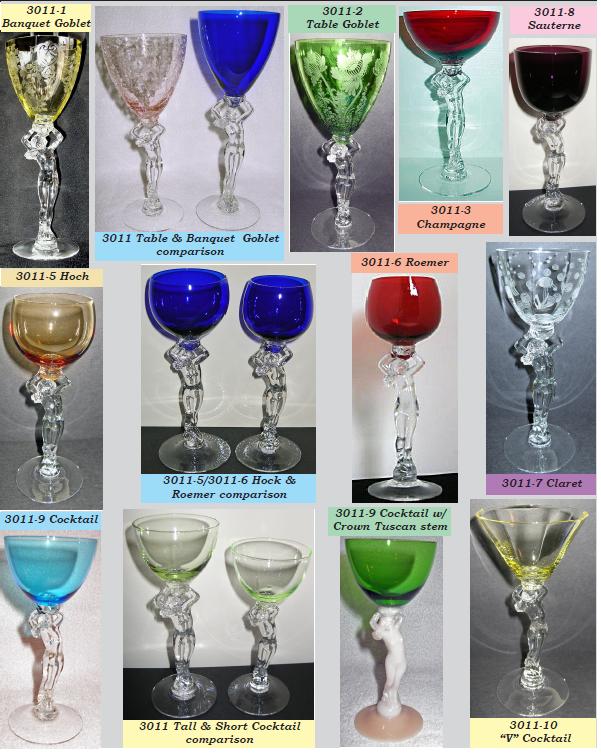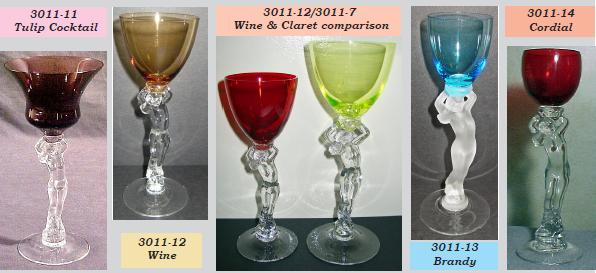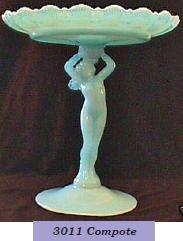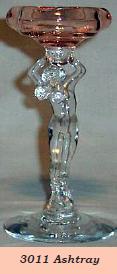A Passion I Have (Cambridge Nudes)
By Squeek Rieker
Issue No. 415 - February 2008
I have been a member of the NCC for over fifteen years. I enjoy collecting, learning about, and sharing the beauty of Cambridge Glass. It doesn't take long to realize after collecting for awhile, the vast range of product manufactured (primarily by hand) by the Cambridge Glass Company. There are a tremendous quantity of patterns, stem lines, colors, and variations of any of the above.
The logical place for my collection to have started is during the years I lived in Cambridge, Ohio. But the collecting bug didn't bite until living in Atlanta, Georgia, and spending time at local antique markets and shops. Not long into collecting Cambridge Glass my focus (and my passion) became the #3011 stem line. The Cambridge Factory Catalog refers to the stem line as the "statuesque" stem line. Though to most collectors, the line is simply referred to as the "nude" stem line.
The first #3011 nude to enter my
collection was the Carmen short
 stem cigarette box and cover.
Followed shortly thereafter by the
Royal Blue ivy ball with frosted
stem, and the Forest Green flared
comport etched Gloria. After that, I
was off to the races!
stem cigarette box and cover.
Followed shortly thereafter by the
Royal Blue ivy ball with frosted
stem, and the Forest Green flared
comport etched Gloria. After that, I
was off to the races!
Through the years I have learned about some of the nuances of the #3011 line, and decided I would like to share some of the findings with others. As most collectors know, the #3011 stem came in a few scaled sizes. The 6-inch stem is most often used on the flared comport, and on the #3011/1 banquet goblet. The 5- inch stem is most often used on the #3011/2 table goblet, and the late color cupped comports. Many folks ask what is the difference between a banquet goblet and a table goblet? Simply, it is the size of the stem. The banquet goblet has a 6-inch stem, while the table goblet has the 5-inch stem. The bowl size is identical, and is stated to be 11- ounces in the 1930-1934 Cambridge Catalog. If you are out at the favorite antique mall, the best way to tell is by placing a U.S. dollar bill next to the stem. If the stem and the dollar bill are essentially the same size, the stem is 6-inches, and thus the goblet is a banquet. If the dollar bill is substantially longer than the stem, the stem is a 5-inch stem, and the goblet is a table goblet. Actually, while many collectors (myself included) call the middle size stem a "5-inch" stem, Mark Nye, in the Cambridge Stemware book, indicates the size to be 4¾ inches.
The shorter stems are the 4-inch stem of the "normal" cocktail, and the stem used on the wine, cordial, and brandy. The reason for the comment of the "normal" cocktail is there do exist some of the #3011/ 9 cocktails which have been attributed to likely being produced in the late 1950's, during the closing days of the Cambridge Glass factory. These particular cocktails are known by collectors as "tall" cocktails, as they use the 5-inch stem, versus the more widely used 4-inch #3011/9 cocktail stem. To the best of my knowledge, there was no line number difference to denote the taller stem of the tall cocktail. Both the 4-inch and 5-inch cocktail appear to have the line number of #3011/9. The "tall" cocktail will invariably be seen with a late color bowl; Moonlight Blue, Pink, Pistachio, Smoke, or with a crackle bowl.
When I first started collecting #3011 stems, who knew some of the lady's secrets? Some of the "early" #3011 ladies have belly-buttons. Apparently, through use of the molds to produce the stems, the detail which originally existed in the mold wore away, and was not placed back into the molds as the molds were cleaned and reworked for production. Some of the other details able to be noted on the stem are the fingers on the hands holding the bowl. On some stems, all ten fingers are plainly visible. Another attribute which is able to be noticed is the sharpness of the nipple. One aspect to which the Cambridge workers apparently paid little attention was the amount of, or lack of, twist in the legs of the lady stem. There are great variations in this area. It is one of many factors which affect the overall height of a stem. We have "matched" pieces in our collection which are differing of nearly one-quarter inch in overall height. The height difference is primarily attributable to the amount of twist in the legs of the #3011 stem.
Recently, I was quite fortunate to complete a #3011 drinking vessel set in one bowl color. My definition of a "complete" drinking vessel set would include the #3011/1 banquet goblet, #3011/2 table goblet, #3011/3 saucer champagne, #3011/5 hoch, #3011/6 roemer, #3011/7 claret, #3011/8 sauterne, #3011/9 cocktail, #3011/10 "V" cocktail, #3011/11 tulip cocktail, #3011/12 wine, #3011/13 brandy, and #3011/14 cordial. "Complete" is a relative term, as one may assert a complete collection might include all crystal stems and another collection might include all frosted or satin stems. Personally, I do not make the distinction, but simply make a mental note that a frosted stem/foot may be more difficult to obtain, or not.

Anybody know what a #3011/4 stem was to be? To the best of my knowledge, the #3011/4 line number does not appear in any Cambridge Catalog. These are the facts which make collectors, years later, go hmmmm. It would logically appear to have been some stem "in between" a saucer champagne and a hoch, whatever that might entail and would have been defined to be in the day.
In the1940 Cambridge Catalog, it is learned the #3011/10 "V" cocktail uses the 3-ounce cocktail bowl from the #3122 stem line. Likewise, the #3011/11 tulip cocktail is a 3-ounce cocktail made with the #3126 stem line bowl. When one holds a #3122 cocktail, it is possible to envision the bowl sitting on a #3011 stem.
Most often the #3011 stem is crystal. The notable exceptions are the solid color #3011 stem line items. The solid colors used for the #3011 line include Crown Tuscan, Windsor Blue, Emerald Green, Mandarin Gold, and Pink. There also exist Ebony #3011/9 cocktails. Imperial Glass also made the #3011/9 cocktail, though the bowl of the Imperial stem is generally larger, and the "wafer" halo above the figure's head does not float as it does in the Cambridge version. There is also an Amber stem #3011/ 9 cocktail which has been attributed to being made by Imperial.
The "solid color" Crown Tuscan #3011 items apparently were made for many years. The Crown Tuscan pieces can be seen with Gold Silkscreen decoration, with Gold Encrusted decorations, as well as Sterling Silver and Platinum decorations. The Crown Tuscan pieces were also sold to Wasserberg for enamel application, commonly called Charleton decoration today.
The Crown Tuscan stem and foot #3011/9 cocktails were produced with colored bowls. These stems are known in Topaz, Royal Blue, Green, Amethyst, Amber, Carmen, and Yellow. It is somewhat ironic that Carmen and Topaz are arguably the most difficult to locate today. Has anyone seen a Crown Tuscan stem and foot with a crystal bowl? It would seem to be the most logical to exist, but this author has not seen one.
 The solid Windsor Blue shell
comport (seen at right), as well as the Crown
Tuscan shell comport are
sometimes found signed with the
"Triangle C". While the Crown
Tuscan pieces are found decorated
with gold, gold encrusted, or with a
Charleton decoration, does anyone
know why a Windsor Blue piece
does not show up with similar
decorations? And, to the best of my
knowledge, there does not exist a
#3011 Windsor Blue drinking
vessel, nor a short stem Windsor
Blue shell comport. Certainly
production oddities.
The solid Windsor Blue shell
comport (seen at right), as well as the Crown
Tuscan shell comport are
sometimes found signed with the
"Triangle C". While the Crown
Tuscan pieces are found decorated
with gold, gold encrusted, or with a
Charleton decoration, does anyone
know why a Windsor Blue piece
does not show up with similar
decorations? And, to the best of my
knowledge, there does not exist a
#3011 Windsor Blue drinking
vessel, nor a short stem Windsor
Blue shell comport. Certainly
production oddities.
The solid Emerald Green and solid
Mandarin Gold #3011 stems are
seen as tall shell comports. Do these
comports exist on the short stem?
There is an example of a solid
Moonlight Blue short-stem shell
comport in the NCC Museum. It is
the only one which I have seen. It
would seem logical that a drinking
vessel would also exist.
 In a few collections exist the solid
pink #3011 stem pieces. The two
pieces known in solid pink are the
short cupped comport and the
ashtray. Anyone have, or know of,
other solid pink #3011 pieces? Does
there exist any solid pink drinking
vessels?
In a few collections exist the solid
pink #3011 stem pieces. The two
pieces known in solid pink are the
short cupped comport and the
ashtray. Anyone have, or know of,
other solid pink #3011 pieces? Does
there exist any solid pink drinking
vessels?
When it comes to the #3011 smoker's items, there are some production oddities which occurred. While it is possible to put together a cigarette box and ashtray set in the primary colors of Carmen, Royal Blue, Amethyst, Amber, Green, and Crystal, putting together a set in some of the later colors is likely improbable. For example, the Smoke ashtray is known to exist. Has anyone every seen a smoke cigarette box? Other examples which seem to follow the same pattern are Moonlight Blue, Pistachio, Pink, and Mocha. All of these colors have been seen in the ashtray. Anyone seen the accompanying cigarette boxes?
There are many other interesting aspects of the Cambridge #3011 stem line. And this is but one of many, many lines that were produced. The creativity and amount of glassware produced by The Cambridge Glass Company is nothing short of phenomenal. As you can tell, the Cambridge "Statuesque Nude" is my collecting passion, and I am always looking to add another unique lady to my collection.
